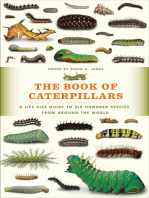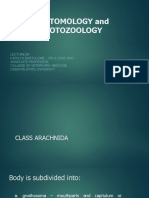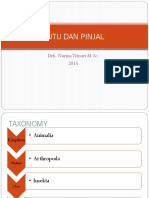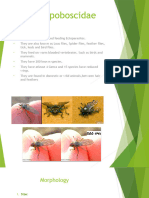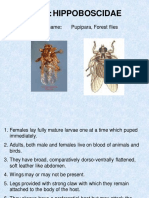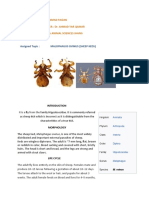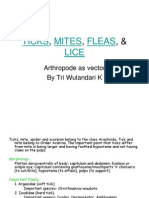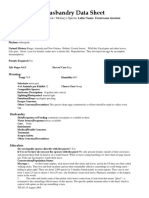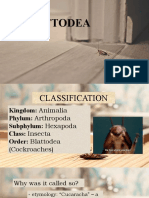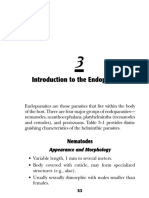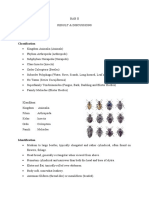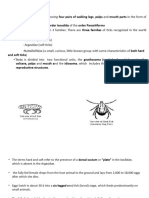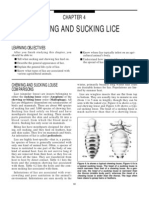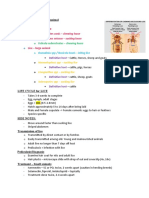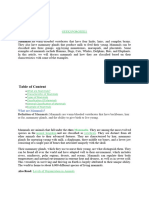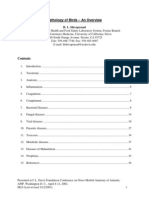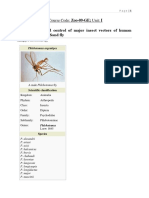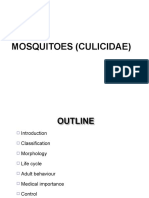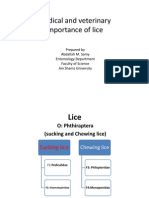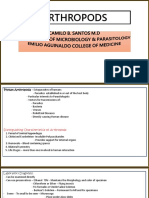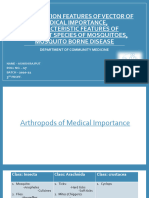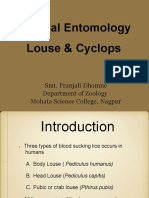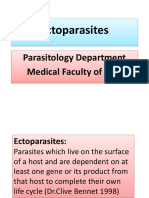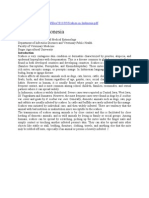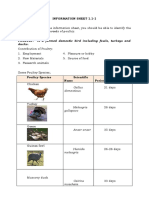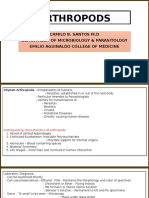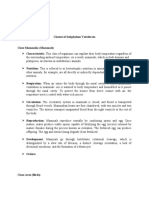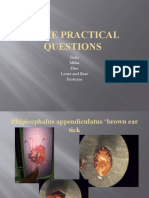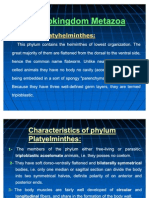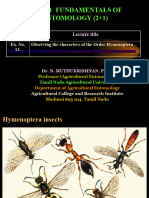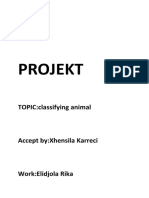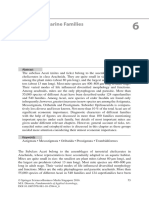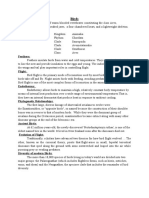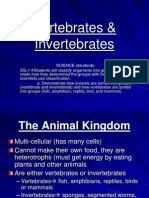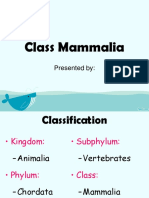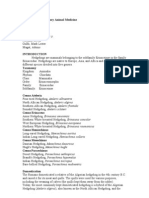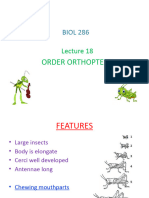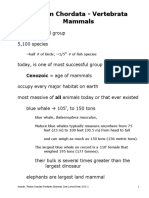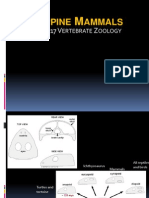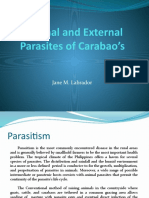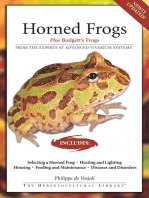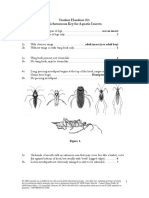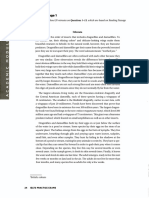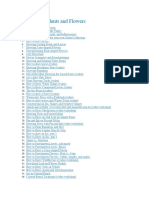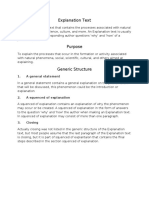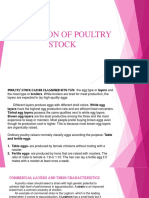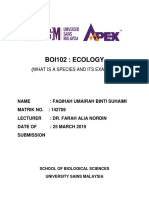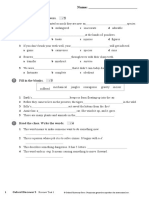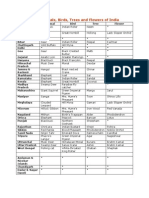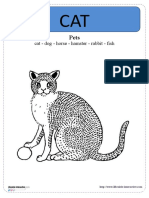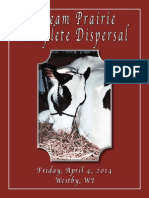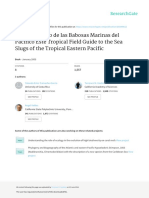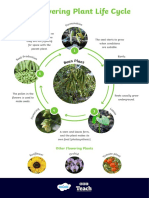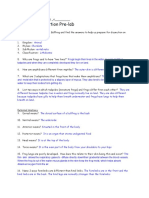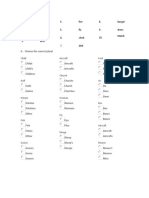Professional Documents
Culture Documents
Order Phthiraptera
Order Phthiraptera
Uploaded by
Lawrence LagartoOriginal Description:
Original Title
Copyright
Available Formats
Share this document
Did you find this document useful?
Is this content inappropriate?
Report this DocumentCopyright:
Available Formats
Order Phthiraptera
Order Phthiraptera
Uploaded by
Lawrence LagartoCopyright:
Available Formats
Order PHTHIRAPTERA (Lice or Kuto)
Wings are absent
Body flattened dorso-ventrally
Eyes are absent or reduced
Head, thorax, and abdomen distinct
Metamorphosis incomplete or gradual (Hemimetabolous development)
Whole life cycle is spent on the host
Lice are permanent ectoparasites of birds and mammals
Cause pediculosis or lousiness or louse infestation
Lice are classified into two suborders:
1. Anoplura – sucking lice
2. Mallophaga – biting lice
Anoplura
Head elongate and narrower than the thorax
Parasites of mammals only, usually host specific
Blood suckers with piercing stylets
1. Family Haematopinidae – no eyes, temporal angles present, legs almost equal in size, paratergal plates
present, has one row of hairs on each abdominal segment
Genera and species:
Haematopinus suis – swine
H. asini – horses
H. eurysternus – cattle
H. quadriperstus – cattle
H. tuberculatus – carabaos and buffaloes
H. nigricantis – Luzon brown deer
Life cycle:
Eggs or “nits” are attached to the hair close to the skin usually at the region of the neck,
shoulder, flank,a nd lower abdomen. Eggs are white to dirty white in color. A female requires a blood
meal before laying eggs. Eggs hatch into first nymph after 2-3 weeks. Nymph molts 3 times within 16
days (5 days/molt) before developing into an adult. First molt occurs after 6 days; second molt – after 4
days; third molt – after 5 days. Adult becomes sexually mature after 3 days. Egg to egg cycle take 23-32
days.
2. Family Linognathidae – no paratergal plates, smaller and more slender than Haematopinus, temporal
angles present, legs unequal, the first pair being the smallest
Genera and Species:
Solenopotes capillatus – cattle
Linognathus vituli – cattle (long-nosed cattle louse)
Linognathus africanus – goats
Linognathus stenopsis – goats
L. pedalis – sheep
L. ovillus – sheep
L. setosus – dogs
Life Cycle:
Eggs are attached to the hair usually on the dewlap, shoulders, sides of the neck, and face anywhere in
the body in heavy infestation. Eggs are dark blue in color and hatch into nymph after 10-13 days. Nymph molts 3
times within 15 days (5 days per molt). Egg to egg cycle requires 23-27 days.
3. Family Pediculidae – eyes present, legs almost equal, paratergal plates present
Genera and Species:
Pediculus humanus capitis – human head louse
Pediculus corporis – human body louse
Pedicinus eurygaster – macaque
Pedicinus obtusus – monkey, baboons
Phthirus (Pthirus in google) pubis – crab louse or pubic louse of man and may occur in the pubic
region, may also occur in the armpit, eyelashes, eyebrows, beard, mustache
(Life cycle skipped, refer to hardcopy)
4. Family Hoplopleuridae – paratergal plates project apically from the body. Tergal and sterna plates
usually distinct
Genera and Species:
Polyplax serrata – mouse
Polyplax spinulosa – mouse rat
Polyplax acanthopus – mice
Polyplax captiosa – mouse
Polyplax pacifica – rats
Haemodipsus ventricosus – rabbits
5. Family Echinophthiriidae – body densely clothed with thick setae, sometimes modified into scales,
sterna plates absent
Genus and Specie:
Antarctophthirus microchir – sea lions
Importance of sucking lice:
Effects on the host:
Cause irritation, itchiness (pruritus) leading to biting, scratching, restlessness, nervousness,
loss of blood, loss of sleep, interrupted feeding, loss of weight, loss of milk, shaggy rough coat,
matted hairs, thickened and darkened skin (vagabond’s disease). Licking results in bruises,
wounds, hairballs in the stomach. Foot louse cause lameness.
Haematopinus suis – may transmit swine fever virus (hog cholera)
Reduce body resistance to viral and bacterial diseases
Transmitter of:
o Borrela recurrentis – cause of epidemic relapsing fever
o Rickettsia prowazekii – cause of typhus fever
o Pasteurella tularensis – cause of tularemia
Transmission is through direct contact, sleeping together, use of same comb, clothes,
swimming trunks, bed sheets, toilet seat
Mallophaga (chewing lice)
Head broader than the thorax
Mouthparts adopted for biting or chewing
Mandibles present. Feed on epithelial debris, feather of birds, dried blood from small wounds, dried
bbjfhdf and tissue fluids.
Parasites of mammals and birds. Those parasitic on mammals have 1 claw while those on birds have 2
claws
Ischnocera – antennae filiform and visible at the sides of the head. No maxillary palpi. 2 claws per leg in species
occurring both in mammals and birds
Mammals – Bovicola, Damalinia, Trichodectes, Felicola
Birds – Anaticola, Columbicola, Chelopistes, Cuclotogaster, Goniodes, Goniocotes, Lipeurus
Amblycera – antennae lie in groove in the sides of the head and are not readily seen.
Mammals (one claw per leg) – Gyropus, Gliricola, Heterodoxus, Trimenopon
Birds (two claws per leg) – Menacanthus, Menopon, Holomenopon
You might also like
- Neo-Gaulish - English DictionaryDocument9 pagesNeo-Gaulish - English DictionaryWēdokū100% (8)
- The Book of Caterpillars: A Life-Size Guide to Six Hundred Species from Around the WorldFrom EverandThe Book of Caterpillars: A Life-Size Guide to Six Hundred Species from Around the WorldDavid G. JamesRating: 4.5 out of 5 stars4.5/5 (4)
- Classification of Class MammaliaDocument43 pagesClassification of Class MammaliaGEETA MOHAN67% (3)
- Entomology and ProtozoologyDocument74 pagesEntomology and ProtozoologyJamaicah PattungNo ratings yet
- Kutu PinjalDocument42 pagesKutu Pinjalmufid hadiNo ratings yet
- Presentation (4) - 1Document20 pagesPresentation (4) - 1f20bfvas1m01038No ratings yet
- 15 Theorical Entomology1Document91 pages15 Theorical Entomology1hhupNo ratings yet
- Family: Hippoboscidae: Common Name: Pupipara, Forest FliesDocument28 pagesFamily: Hippoboscidae: Common Name: Pupipara, Forest FliesAvitus Dastan CastoNo ratings yet
- MALOPHAGUS OVINUS - Docx FaiziDocument3 pagesMALOPHAGUS OVINUS - Docx FaiziMuhammad FaizanNo ratings yet
- Ticks, Mites, Fleas, Lice As A VectorDocument24 pagesTicks, Mites, Fleas, Lice As A VectorAditya Rachman Van Der ArjunaqueeNo ratings yet
- Mcleary's Spectre Husbandry Data SheetDocument2 pagesMcleary's Spectre Husbandry Data SheetAlmaNo ratings yet
- HouseflyDocument14 pagesHouseflyPratik KhamkarNo ratings yet
- BlattodeaDocument20 pagesBlattodeaHoney Princess RuizNo ratings yet
- Introduction To The Endoparasites: NematodesDocument24 pagesIntroduction To The Endoparasites: NematodesdanielaNo ratings yet
- Bab Pembahasan EntomologiDocument11 pagesBab Pembahasan EntomologiRahmayulis 123No ratings yet
- Vector Biology Generic and Post BasicDocument66 pagesVector Biology Generic and Post BasicTilahun TesemaNo ratings yet
- LPNE2601 Chap 4Document7 pagesLPNE2601 Chap 4Changi RenandaNo ratings yet
- Ectoparasities of Domestic AnimalDocument9 pagesEctoparasities of Domestic AnimalsharonNo ratings yet
- PresenDocument12 pagesPresenrayson thapaNo ratings yet
- Chapter 8: The Triploblastic, Acoelomate Body PlanDocument5 pagesChapter 8: The Triploblastic, Acoelomate Body PlanJiboy MixNo ratings yet
- Animals and FoodDocument12 pagesAnimals and FoodEpics GodfreyNo ratings yet
- Avian PathologyDocument48 pagesAvian PathologyEric Cheah100% (1)
- Sand Fly PDFDocument4 pagesSand Fly PDFSneha SahaNo ratings yet
- 2 MosquitoesDocument41 pages2 MosquitoesAnmut AschaleNo ratings yet
- Entomology - Members of Class Insecta, Order DipteraDocument88 pagesEntomology - Members of Class Insecta, Order Dipteramiki100% (1)
- Animal Kingdom ClassificationDocument24 pagesAnimal Kingdom ClassificationGel Novida-ChavezNo ratings yet
- Medical and Veterinary Importance of LiceDocument10 pagesMedical and Veterinary Importance of LicedrabedoooNo ratings yet
- Arthropods PowerpointDocument61 pagesArthropods PowerpointJaybee SarmientoNo ratings yet
- Vectors PSM ParksDocument36 pagesVectors PSM ParksAshish RajputNo ratings yet
- Louseandcyclops 200514190947Document21 pagesLouseandcyclops 200514190947Smpp MondhaNo ratings yet
- Animal Kingdom NotesDocument9 pagesAnimal Kingdom NotesVicky KinsNo ratings yet
- Bakul K13 Ectoparasite - RevisiDocument28 pagesBakul K13 Ectoparasite - RevisiagnesNo ratings yet
- Kazi Nazrul University: Project Report On Parasitic VertebrateDocument12 pagesKazi Nazrul University: Project Report On Parasitic VertebrateAnas Arshad100% (2)
- Di IndonesiaDocument3 pagesDi IndonesiaMirlinda HartinNo ratings yet
- Information Sheet 1.1-1: POULTRY: Is A Farmed Domestic Bird Including Fowls, Turkeys and DucksDocument78 pagesInformation Sheet 1.1-1: POULTRY: Is A Farmed Domestic Bird Including Fowls, Turkeys and DucksCharlesBallesteros50% (2)
- 22 SiphonapteraDocument16 pages22 SiphonapteraSmpp MondhaNo ratings yet
- أسئلة وزارية باسم ناجيDocument15 pagesأسئلة وزارية باسم ناجيSoon SheedNo ratings yet
- Arthropods: Camilo B. Santos M.D Department of Microbiology & Parasitology Emilio Aguinaldo College of MedicineDocument61 pagesArthropods: Camilo B. Santos M.D Department of Microbiology & Parasitology Emilio Aguinaldo College of MedicineBea SamonteNo ratings yet
- Classes Under Subphylum VertebrataDocument6 pagesClasses Under Subphylum VertebrataREYGILINE CLEMENTENo ratings yet
- Hove Practical QuestionsDocument104 pagesHove Practical QuestionsMusiiwa FariraiNo ratings yet
- Subkingdom Metazoa 2Document28 pagesSubkingdom Metazoa 2Ahmed OrabyNo ratings yet
- Ex. No. 13 Observing The Characters of HymenopteraDocument21 pagesEx. No. 13 Observing The Characters of Hymenopteraakshayaa aswanthNo ratings yet
- Document 1Document15 pagesDocument 1angel anglNo ratings yet
- Important Acarine FamiliesDocument87 pagesImportant Acarine Familiesmaria riveraNo ratings yet
- Fleas, Ticks, Lice, Mites, and Flies: Animal HealthDocument8 pagesFleas, Ticks, Lice, Mites, and Flies: Animal HealthAwwal DayyabuNo ratings yet
- Birds: ClassificationDocument4 pagesBirds: ClassificationAbdullah BhattiNo ratings yet
- PresenDocument13 pagesPresenPrashant ThapaNo ratings yet
- Vertebrates and InvertebratesDocument15 pagesVertebrates and Invertebratesapi-260132447No ratings yet
- Medical Parasitology: Protozoa Helminth ArthropodDocument73 pagesMedical Parasitology: Protozoa Helminth Arthropodapi-19916399No ratings yet
- Biology Yyy YyyDocument62 pagesBiology Yyy YyyLovely FlowerNo ratings yet
- HedgehogDocument9 pagesHedgehogRalph Laurence GulfoNo ratings yet
- RatDocument33 pagesRatoguz1985100% (1)
- BIOL 286 Lecture 18 ORTHOPTERA With AnnotationsDocument31 pagesBIOL 286 Lecture 18 ORTHOPTERA With Annotationsevahhassane2003No ratings yet
- Other FlieDocument21 pagesOther Flieammaithaththaibuduwewa2No ratings yet
- Louse - WikipediaDocument13 pagesLouse - WikipediaRico MartinezNo ratings yet
- Phylum Chordata MammalsDocument64 pagesPhylum Chordata Mammalsparth tyagiNo ratings yet
- Mammals Charcteristics Bio 117Document77 pagesMammals Charcteristics Bio 117MilitaryShellfishEyeNo ratings yet
- Internal & External Parasites of CarabaoDocument35 pagesInternal & External Parasites of CarabaoJane LabradorNo ratings yet
- Parasites ..Practical 2Document98 pagesParasites ..Practical 2Radhwan Hameed Asad100% (1)
- Best Control For FliesDocument30 pagesBest Control For FliesDavidNo ratings yet
- Wildlife Fact File - Fish - Pgs. 31-40Document20 pagesWildlife Fact File - Fish - Pgs. 31-40ClearMind84100% (2)
- Student Handout #2-Dichotomous Key For Aquatic InsectsDocument7 pagesStudent Handout #2-Dichotomous Key For Aquatic InsectsAndres Germán FuentesNo ratings yet
- IELTS Reading 1Document3 pagesIELTS Reading 1amaral.joceNo ratings yet
- Black Soldier Fly - Hermetia IllucensDocument6 pagesBlack Soldier Fly - Hermetia Illucenshallymahmod0% (1)
- John Muir Laws - ListDocument12 pagesJohn Muir Laws - ListShilpaNo ratings yet
- Explanation TextDocument4 pagesExplanation TextOspodo100% (1)
- Report in TLE7Document12 pagesReport in TLE7Hannah Nicole MoredoNo ratings yet
- Class 4 Evs Keynotes For Busy MonthDocument4 pagesClass 4 Evs Keynotes For Busy MonthPradeep AppuNo ratings yet
- Tele - IsHITA 4 U Cockroach FlowchartDocument6 pagesTele - IsHITA 4 U Cockroach Flowchartlakshya singhalNo ratings yet
- 4C Week 10 - Online - E13Document11 pages4C Week 10 - Online - E13Thị Thùy Trang ĐỗNo ratings yet
- Boi102: Ecology: (What Is A Species and Its Example)Document5 pagesBoi102: Ecology: (What Is A Species and Its Example)Jian TongNo ratings yet
- Review Test 1: Circle The Correct Answers. / 5Document4 pagesReview Test 1: Circle The Correct Answers. / 5XeniaNo ratings yet
- State Animals, Birds, Trees and Flowers of IndiaDocument2 pagesState Animals, Birds, Trees and Flowers of IndiakuttyboyNo ratings yet
- 7 Familles AnimauxDocument43 pages7 Familles AnimauxMarisa García Del ValleNo ratings yet
- Ivp Newsletter 13 Feb23Document7 pagesIvp Newsletter 13 Feb23api-614236477No ratings yet
- Adventures of A Wildlife Warden by E.R.C.Davidar PDFDocument68 pagesAdventures of A Wildlife Warden by E.R.C.Davidar PDFravichan_2010No ratings yet
- OU OW PackDocument112 pagesOU OW PackyyyNo ratings yet
- Sale Catalog - Dream-Prairie Complete DispersalDocument140 pagesSale Catalog - Dream-Prairie Complete DispersalHolstein PlazaNo ratings yet
- Assignment: Design An Animal For A HabitatDocument2 pagesAssignment: Design An Animal For A HabitatJohn OsborneNo ratings yet
- Sheep (Ovis Aries) Are: Quadrupedal Ruminant Mammals Livestock Even-Toed UngulatesDocument7 pagesSheep (Ovis Aries) Are: Quadrupedal Ruminant Mammals Livestock Even-Toed Ungulatesfilan0fisteku-502158No ratings yet
- Ornamental Fish - Biology of Aquarium Fishes - PPTDocument33 pagesOrnamental Fish - Biology of Aquarium Fishes - PPTsatyam jha100% (1)
- Zoology Report 1st Year 1Document15 pagesZoology Report 1st Year 1Friend Goog75% (4)
- Guía de Campo de Las Babosas Marinas Del Pacífico Este Tropical Field Guide To The Sea Slugs of The Tropical Eastern PacificDocument133 pagesGuía de Campo de Las Babosas Marinas Del Pacífico Este Tropical Field Guide To The Sea Slugs of The Tropical Eastern PacificBayardo AguilarNo ratings yet
- Wolf e A4Document0 pagesWolf e A4Riadh FantarNo ratings yet
- Comparing Different-Life Cycles PostersDocument7 pagesComparing Different-Life Cycles PostersSindia DamianNo ratings yet
- Behavior Differentiation Between Wild Quail and Domestic QuailDocument6 pagesBehavior Differentiation Between Wild Quail and Domestic QuailCamila AndreaNo ratings yet
- Frogdissectionpre LabzachDocument2 pagesFrogdissectionpre Labzachapi-347431785No ratings yet
- CH 21 Crustacea PDFDocument81 pagesCH 21 Crustacea PDFSire UdemeNo ratings yet
- Berry 2. Book 3. Arch 4. Fire 5. Fly 6. Clock 7. Dish 8. Burger 9. Dress 10. MatchDocument1 pageBerry 2. Book 3. Arch 4. Fire 5. Fly 6. Clock 7. Dish 8. Burger 9. Dress 10. MatchConsuelo Esmerlda RiosNo ratings yet

